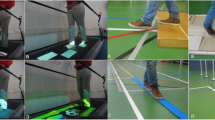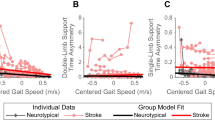Abstract
After stroke, the ability to make step adjustments during walking is reduced and requires more attention, which may cause problems during community walking. The C-Mill is an innovative treadmill augmented with visual context (e.g., obstacles and stepping targets), which was designed specifically to practice gait adaptability. The objective of this study was to determine whether C-Mill gait adaptability training can help to improve gait adjustments and associated attentional demands. Sixteen community-ambulating persons in the chronic stage of stroke (age: 54.8 ± 10.8 years) received ten sessions of C-Mill training within 5–6 weeks. Prior to and after the intervention period, participants performed an obstacle-avoidance task with and without a secondary attention-demanding auditory Stroop task to assess their ability to make gait adjustments (i.e., obstacle-avoidance success rates) as well as the associated attentional demands (i.e., Stroop success rates, stratified for pre-crossing, crossing, and post-crossing strides). Obstacle-avoidance success rates improved after C-Mill training from 52.4 ± 16.3 % at pretest to 77.0 ± 16.4 % at posttest (p < 0.001). This improvement was accompanied by greater Stroop success rates during the obstacle-crossing stride only (pretest: 62.9 ± 24.9 %, posttest: 77.5 ± 20.4 %, p = 0.006). The observed improvements in obstacle-avoidance success rates and Stroop success rates were strongly correlated (r = 0.68, p = 0.015). The ability to make gait adjustments and the associated attentional demands can be successfully targeted in persons with stroke using C-Mill training, which suggests that its underlying assumptions regarding motor control are appropriate. This study lends support and guidance for designing a randomized controlled trial to further examine the potential of C-Mill training for improving safe community ambulation after stroke.





Similar content being viewed by others
References
Canning CG, Ada L, Paul SS (2006) Is automaticity of walking regained after stroke? Disabil Rehabil 28:97–102. doi:10.1080/09638280500167712
Cohen G, Martin M (1975) Hemisphere differences in an auditory Stroop test. Percept Psychophys 17:79–83
Collen FM, Wade DT, Bradshaw CM (1990) Mobility after stroke: reliability of measures of impairment and disability. Int Disabil Stud 12:6–9
Collin C, Wade D (1990) Assessing motor impairment after stroke: a pilot reliability study. J Neurol Neurosurg Psychiatry 53:576–579
de Bruin ED, Reith A, Dorflinger M (2011) Feasibility of strength-balance training extended with computer game dancing in older people; does it affect dual task costs of walking? J Nov Physiother 1:1–7. doi:10.4172/2165-7025.1000104
Den Otter AR, Geurts AC, de Haart M, Mulder T, Duysens J (2005) Step characteristics during obstacle avoidance in hemiplegic stroke. Exp Brain Res 161:180–192. doi:10.1007/s00221-004-2057-0
Field A (2009) Discovering statistics using SPSS, 3rd edn. Sage, New York
Fonteyn EMR, Heeren A, Engels J-JC, Boer JJD, van de Warrenburg BPC, Weerdesteyn V (2014) Gait adaptability training improves obstacle avoidance and dynamic stability in patients with cerebellar degeneration. Gait Posture 40:247–251. doi:10.1016/j.gaitpost.2014.04.190
Friedman PJ (1990) Gait recovery after hemiplegic stroke. Int Disabil Stud 12:119–122
Gladstone DJ, Danells CJ, Black SE (2002) The Fugl-Meyer assessment of motor recovery after stroke: a critical review of its measurement properties. Neurorehabil Neural Repair 16:232–240. doi:10.1177/154596802401105171
Go AS et al (2013) Executive summary: heart disease and stroke statistics—2013 update: a report from the American heart association. Circulation 127:143–152. doi:10.1161/CIR.0b013e318282ab8f
Heeren A, van Ooijen MW, Geurts ACH, Day BL, Janssen TWJ, Beek PJ, Roerdink M, Weerdesteyn V (2013) Step by step: a proof of concept study of C-Mill gait adaptability training in the chronic phase after stroke. J Rehabil Med 45:616–622. doi:10.2340/16501977-1180
Hegeman J, Weerdesteyn V, van den Bemt B, Nienhuis B, van Limbeek J, Duysens J (2012) Dual-tasking interferes with obstacle avoidance reactions in healthy seniors. Gait Posture 36:236–240. doi:10.1016/j.gaitpost.2012.02.024
Holleran CL, Straube DD, Kinnaird CR, Leddy AL, Hornby TG (2014) Feasibility and potential efficacy of high-intensity stepping training in variable contexts in subacute and chronic stroke. Neurorehabil Neural Repair 28:643–651. doi:10.1177/1545968314521001
Houdijk H, van Ooijen MW, Kraal JJ, Wiggerts HO, Polomski W, Janssen TW, Roerdink M (2012) Assessing gait adaptability in people with a unilateral amputation on an instrumented treadmill with a projected visual context. Phys Ther 92:1452–1460. doi:10.2522/ptj.20110362
Hyndman D, Ashburn A (2004) Stops walking when talking as a predictor of falls in people with stroke living in the community. J Neurol Neurosurg Psychiatry 75:994–997. doi:10.1136/jnnp.2003.016014
Hyndman D, Ashburn A, Stack E (2002) Fall events among people with stroke living in the community: circumstances of falls and characteristics of fallers. Arch Phys Med Rehabil 83:165–170. doi:10.1053/apmr.2002.28030
Hyndman D, Ashburn A, Yardley L, Stack E (2006) Interference between balance, gait and cognitive task performance among people with stroke living in the community. Disabil Rehabil 28:849–856. doi:10.1080/09638280500534994
Jaffe DL, Brown DA, Pierson-Carey CD, Buckley EL, Lew HL (2004) Stepping over obstacles to improve walking in individuals with poststroke hemiplegia. J Rehabil Res Dev 41:283–292. doi:10.1682/JRRD.2004.03.0283
Jorgensen HS, Nakayama H, Raaschou HO, Olsen TS (1995) Recovery of walking function in stroke patients: the Copenhagen Stroke Study. Arch Phys Med Rehabil 76:27–32
Lajoie Y, Teasdale N, Bard C, Fienry M (1993) Attentional demands for static and dynamic equilibrium. Exp Brain Res 97:139–144
Langhorne P, Coupar F, Pollock A (2009) Motor recovery after stroke: a systematic review. Lancet Neurol 8:741–754. doi:10.1016/S1474-4422(09)70150-4
Langhorne P, Bernhardt J, Kwakkel G (2011) Stroke rehabilitation. Lancet 377:1693–1702. doi:10.1016/S0140-6736(11)60325-5
Mehrholz J, Wagner K, Rutte K, Meissner D, Pohl M (2007) Predictive validity and responsiveness of the functional ambulation category in hemiparetic patients after stroke. Arch Phys Med Rehabil 88:1314–1319. doi:10.1016/j.apmr.2007.06.764
Mirelman A, Maidan I, Herman T, Deutsch JE, Giladi N, Hausdorff JM (2011) Virtual reality for gait training: can it induce motor learning to enhance complex walking and reduce fall risk in patients with parkinson’s disease? J Gerontol A Biol Sci Med Sci 66:234–240. doi:10.1093/gerona/glq201
Pestronk A, Florence J, Levine T, Al-Lozi MT, Lopate G, Miller T, Ramneantu I, Waheed W, Stambuk M (2004) Sensory exam with a quantitative tuning fork: rapid, sensitive and predictive of SNAP amplitude. Neurology 62:461–464
Pichierri G, Coppe A, Lorenzetti S, Murer K, de Bruin ED (2012) The effect of a cognitive-motor intervention on voluntary step execution under single and dual task conditions in older adults: a randomized controlled pilot study. Clin Interv Aging 7:175–184. doi:10.2147/CIA.S32558
Potocanac Z, Hoogkamer W, Carpes FP, Pijnappels M, Verschueren SMP, Duysens J (2014) Response inhibition during avoidance of virtual obstacles while walking. Gait Posture 39:641–644. doi:10.1016/j.gaitpost.2013.07.125
Roerdink M, Beek PJ (2009) Device for displaying target indications for foot movements to persons with a walking disorder. US patent 2009246746-A1 (October 1, 2009), European patent 2106779-A1 (October 7, 2009), Japanese patent 2009240775-A (October 22, 2009), and Dutch patent 1035236-C2 (October 1, 2009)
Roerdink M, Lamoth CJ, van Kordelaar J, Elich P, Konijnenbelt M, Kwakkel G, Beek PJ (2009) Rhythm perturbations in acoustically paced treadmill walking after stroke. Neurorehabilitation Neural Repair 23:668–678. doi:10.1177/1545968309332879
Said CM, Goldie PA, Patla AE, Sparrow WA, Martin KE (1999) Obstacle crossing in subjects with stroke. Arch Phys Med Rehabil 80:1054–1059. doi:10.1016/S0003-9993(99)90060-6
Schillings AM, Van Wezel BM, Duysens J (1996) Mechanically induced stumbling during human treadmill walking. J Neurosci Methods 67:11–17. doi:10.1016/0165-0270(95)00149-2
Siu K-C, Catena RD, Chou L-S, Donkelaar P, Woollacott MH (2008) Effects of a secondary task on obstacle avoidance in healthy young adults. Exp Brain Res 184:115–120. doi:10.1007/s00221-007-1087-9
Smulders E, van Lankveld W, Laan R, Duysens J, Weerdesteyn V (2011) Can improved obstacle avoidance performance explain the effectiveness of a multimodal falls prevention program for persons with osteoporosis? J Am Geriatr Soc 59:368–369. doi:10.1111/j.1532-5415.2011.03254.x
Smulders K, van Swigchem R, de Swart BJ, Geurts AC, Weerdesteyn V (2012) Community-dwelling people with chronic stroke need disproportionate attention while walking and negotiating obstacles. Gait Posture 36:127–132. doi:10.1016/j.gaitpost.2012.02.002
van Ooijen MW, Roerdink M, Trekop M, Visschedijk J, Janssen TW, Beek PJ (2013) Functional gait rehabilitation in elderly people following a fall-related hip fracture using a treadmill with visual context: design of a randomized controlled trial. BMC Geriatr 13:34. doi:10.1186/1471-2318-13-34
van Swigchem R, van Duijnhoven HJ, den Boer J, Geurts AC, Weerdesteyn V (2012) Effect of peroneal electrical stimulation versus an ankle-foot orthosis on obstacle avoidance ability in people with stroke-related foot drop. Phys Ther 92:398–406. doi:10.2522/ptj.20100405
van Swigchem R, van Duijnhoven HJ, den Boer J, Geurts AC, Weerdesteyn V (2013) Deficits in motor response to avoid sudden obstacles during gait in functional walkers poststroke. Neurorehabilitation Neural Repair 27:230–239. doi:10.1177/1545968312462070
Weerdesteyn V, Schillings AM, van Galen GP, Duysens J (2003) Distraction affects the performance of obstacle avoidance during walking. J Mot Behav 35:53–63. doi:10.1080/00222890309602121
Weerdesteyn V, Nienhuis B, Hampsink B, Duysens J (2004) Gait adjustments in response to an obstacle are faster than voluntary reactions. Hum Mov Sci 23:351–363. doi:10.1016/j.humov.2004.08.011
Weerdesteyn V, Rijken H, Geurts ACH, Smits-Engelsman BCM, Mulder T, Duysens J (2006) A five-week exercise program can reduce falls and improve obstacle avoidance in the elderly. Gerontology 52:131–141. doi:10.1159/000091822
Weerdesteyn V, Nienhuis B, Geurts AC, Duysens J (2007) Age-related deficits in early response characteristics of obstacle avoidance under time pressure. J Gerontol A Biol Sci Med Sci 62:1042–1047
Weerdesteyn V, de Niet M, van Duijnhoven HJ, Geurts AC (2008) Falls in individuals with stroke. J Rehabil Res Dev 45:1195–1213. doi:10.1682/JRRD.2007.09.0145
Wickelgren WA (1977) Speed-accuracy tradeoff and information processing dynamics. Acta Psychol 41:67–85
Woollacott M, Shumway-Cook A (2002) Attention and the control of posture and gait: a review of an emerging area of research. Gait Posture 16:1–14. doi:10.1016/S0966-6362(01)00156-4
Yamada M, Aoyama T, Arai H, Nagai K, Tanaka B, Uemura K, Mori S, Ichihashi N (2012) Complex obstacle negotiation exercise can prevent falls in community-dwelling elderly Japanese aged 75 years and older. Geriatr Gerontol Int 12:461–467. doi:10.1111/j.1447-0594.2011.00794.x
Yang YR, Tsai MP, Chuang TY, Sung WH, Wang RY (2008) Virtual reality-based training improves community ambulation in individuals with stroke: a randomized controlled trial. Gait Posture 28:201–206. doi:10.1016/j.gaitpost.2007.11.007
Acknowledgments
The authors thank Judith Vloothuis, rehabilitation physician at Reade, Centre for Rehabilitation and Rheumatology, for conducting the intake visits. The authors also thank the physical therapists Peter Elich, Sifra Broeder, Sjoerd Heubers, and Jasper den Boer for their feedback on the training intervention. From the department of Rehabilitation at the Radboud University, the authors thank Coen Bongers, Digna de Kam, and Jorik Nonnekes for supporting data collection and Roland Loeffen and Roos van Swigchem for their technical support. This study was funded by the Dutch Brain Foundation (‘Hersenstichting Nederland’), Grant 2010(1)-25. The contributions of Melvyn Roerdink and Vivian Weerdesteyn were supported by Veni Grants 451-09-024 and 916-10-106, respectively, of The Netherlands Organization for Scientific Research (NWO).
Conflict of interest
ForceLink (producer of the C-Mill) was not financially involved in this study and had no influence on the interpretation of data and the final conclusions.
Author information
Authors and Affiliations
Corresponding author
Electronic supplementary material
Below is the link to the electronic supplementary material.
Supplementary material 1 (WMV 10670 kb)
Rights and permissions
About this article
Cite this article
van Ooijen, M.W., Heeren, A., Smulders, K. et al. Improved gait adjustments after gait adaptability training are associated with reduced attentional demands in persons with stroke. Exp Brain Res 233, 1007–1018 (2015). https://doi.org/10.1007/s00221-014-4175-7
Received:
Accepted:
Published:
Issue Date:
DOI: https://doi.org/10.1007/s00221-014-4175-7




